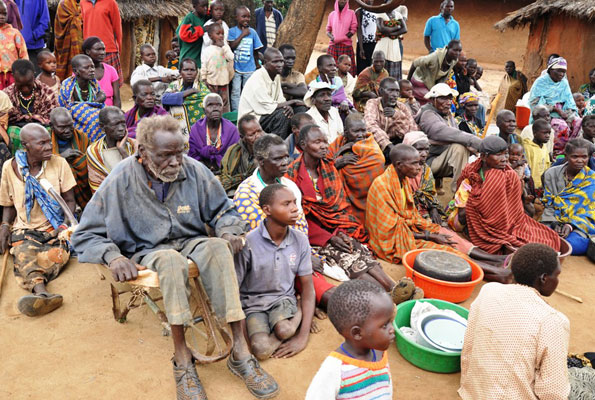Prime
46 dead as hunger pounds Karamoja, Teso

A group of elderly people and children in Moroto District wait for relief food that was distributed by the government in 2013. PHOTO/STEVEN ARIONG
What you need to know:
A few families in Karamoja were rescued by the government at the weekend with food, but homes in Teso are also reported to be living on a meal a day, and local leaders fear that the situation could get worse.
Karamoja/Teso
As the rains began showering Karamoja and Teso sub-regions, it was welcomed as a blessing, since crops were going to grow. But as the rains continued, the joy was turned into uneasiness as the heavy downpour started flooding gardens, washing away crops and roads. What that later meant was that there would not be any crops to harvest this season. That was in the first quarter of this year.
Today, the thousands of residents in Karamoja are going for days without food, while others are on the brink of death as a result of starvation. The severe hunger has so far killed 46 people in Karamoja in the last two months, according to local authorities. The worst hit district is Kaabong, where 20 people have been confirmed dead due to starvation. The other affected districts are Napak and Moroto.
The severe food shortage has forced more than 5,000 Karimojongs to flee the country into neighbouring Kenya, where the government is supplying food to its citizens. The government, through the Disaster Preparedness ministry, at the weekend launched an emergency food distribution initiative with the aim to rescue hundreds of starving families in the seven districts of Karamoja.
Emergency food
While launching the initiative in Moroto Municipality on Saturday, the State Minister for Disaster Preparedness, Mr Musa Ecweru, said the government will continue distributing emergency food to the most affected families in the region.
Mr Joseph Komol Midi, the Kaabong District LC5 chairperson, said several households had planted crops which they expected would provide them with food, but all the crops were destroyed by the floods. He said the worst hit sub-counties in Kaabong include Kapedo, Loyoro, Kamion, Kalapata and Kaabong Town Council. The Kaabong senior clinical officer, Mr James Lokope, said people have died of hunger, according to post-mortem reports.
In Napak District, five people died due to hunger, this is according to the district health director, Dr James Lemukol. He said the food crisis has also increased the level of malnutrition in the district.
Effect
“Almost every household is affected by malnutrition because of lack of balanced diet,” he said. He, however, could not readily give figures of the people affected my malnutrition. The LC5 chairperson of Napak, Mr Joseph Lomonyang, said the most affected sub-counties in the district are Ngoleriet, Lokopo, Lopei and Lotome. Ms Esther Munyes, one of the Ngoleriet Sub-county officials, said the hunger situation has worsened the health of elderly persons.
In Moroto District, the most affected areas are Rupa Sub-county, Nadunget and Moroto Municipality.
The LC1 chairperson of Campswhili Jin, Mr Mohamed Akida, said since June 2010 to June, 22 people have been reported dead due to starvation in his area.
Meanwhile, more than 10,000 acres of farm gardens in Serere District have dried up, leaving thousands of people on the verge of starvation as the drought continues to scorch the crops in the area.
Mr Apollo Ewidu, the LC3 chairperson of Bugondo Sub-county, told the Daily Monitor that the gardens in his area are destroyed, and that about 8,000 people are surviving on a single meal a day. He also warned that the numbers could soon swell since the little grains for last year are running out of stock. “We have had no harvest this season, all the crops have dried up,” Mr Ewidu said. He added that the repeat of the 1994 and 1997 famine could happen gain given the current images of the dried-up crops in the gardens, adding that there is urgent need for assistance from the government.
Appeal
Mr Ewidu said there is need for establishment of regional government irrigation schemes to cater for such eventualities, citing Labwor and Odina. He said the government land on the shores of Lake Kyoga should be used.
Mr Sylvester Okaje, a resident of Kadugulu Sub-county, said the entire 66 gardens belonging to his clan have virtually perished, and that they are entirely going with only one meal a day. “In case, rains comeback we cannot plant because we don’t have seeds, “he added.
Mr James Omangino, a Kadugulu village health team worker, confirmed that certain signs of malnutrition are starting to be seen among the children below the age of 10. “We are getting into the second season, but there is no rain,” he said.
In the history of Teso, Serere District has often been a food basket that supplies the region with food in times of scarcity, but with such occurrences, the other districts would have to look elsewhere as they are also severely injured.
The drought in Teso
Immediately farmers finished the first weeding in March, the dry spell set in and since then, there has been no rain. Residents in Serere District are in a dire need of food and their economic stand is worsened as there is no produce to sell.
In Bugondo Sub-county, the gardens are destroyed and about 8,000 people are surviving on a single meal a day, but local authorities say the numbers could soon swell since the little grains for last year are running out of stock. Local leaders are now appealing to the government to avail irrigation technology to reduce on the dependence on rain for farming.




